Advice about slab doors?
Were having trouble choosing our cabinet door style. We generally prefer contemporary styles and simple, clean lines. Although the current kitchen cabinets have very traditional, raised panel doors (which we dislike), the rest of the house has slab doors and the simplest of moldings. Thus, although most homes in our area are quite traditional, we thought weÂd go with slab cabinet doors (for continuity with the rest of our house and because we like their looks).
After doing some shopping, however, weÂre starting to wonder about slab door construction. It seems that warping is a potential problem, which can be addressed different ways:
-- veneer on MDF
-- veneer on particle board
-- veneer on plywood
-- solid wood strips fastened together somehow, sometimes with battens on the back
WeÂve heard good and bad things about each approach. Not surprisingly, people seem to favor what they sell and this has left us feeling confused and conflicted E.g., we like the fact that veneers are available in some interesting woods and some cabinet companies offer bookmatching, but we worry about damaging the veneer and not really having refinishing options. At the same time weÂre worried that solid wood slabs would warp more, and DH isnÂt keen on battens. We donÂt want anything that looks cheap or wears poorly and donÂt want to deal with things like hinges or other hardware pulling out of particle board or MDF. Some people have suggested that we forget about slab and go for something like Shaker (which I gather are much more popular).
Any advice? E.g., is one type of slab door better than another? Are all slab doors problematic or are we worrying needlessly about these things?
Comments (26)
daveinorlado
13 years agolast modified: 9 years agoveneer in general is created to bring down price. It costs less to produce engineered products regardless of the materials used.
Think about it though your raised panel doors are either veneer or solid wood. You do not hear much about a raised panel door warping. Sure it happens but it is the exception and not the rule. I would not stress over the solid wood doors warping.
Note that most truly modern looks are not intended to show solid wood stips. The surface is a never ending grain. A laminate or veneer product. Some modern looks are only achievable by the veneer look. it is what it is. Edgebanding is what I would would worry about in my choice of a slab veneer door. That is what is most likely to come apart I would think.
Shop around and brand names of slab and euro looking products some companies have them in the low cost of door styles and others have them on the high side.
dianalo
13 years agolast modified: 9 years agoHi,
We are going with IKEA cabs and they have several slab front styles. If you do a search here with IKEA as the keyword, you will see how many people are happy with them and learn a lot about them. If you are not familiar with the IKEA kitchens of recent years, you may be surprised. Consumer Reports rates them highly!Related Discussions
Slab poured., now, What to do about existing pipe in slab?
Q
Comments (2)Time for the GC to man up and do some jackhammering. At his cost for everything. Inluding the repairs that may be needed from the abrasive concrete dust....See MoreNeed advice about enlarging rough opening for sliding doors
Q
Comments (2)The sizes given you by the Marvin rep are right on. You should discuss the sizing issue with your contractor but you need a minimum RO of 97 1/8" with a 1/4" on each side rather than Marvin's recommended 1/2". Simpson makes a product called a header hanger that lets you replace some of the trimmers without compromising structural integrity. Of the products that you mention, I would recommend the Marvin. Good luck!...See MoreNeed help on preventing mold in 5' deep cabinets on slab. Advice??
Q
Comments (2)That matches my experience in a NY home we'd house-sat in this summer. I had to have the dehumidifier set at 45% to keep the musty smell down. As for our own Calif. basement, we're in a pretty warm dry area, so I'd figured the key is to prevent big surface temperature differences, to prevent condensation. But I found that one of the damp-rid chemical absorbents was pulling quite a bit of water out of the air, so we do need to monitor the humidity in the cabinet in addition to whatever we do to the cement surfaces....See Moreadvice about patio doors
Q
Comments (4)If you are looking for a more modern style frame (narrower rails and stiles), take a peak at some of the fiberglass doors out there....See Moreantss
13 years agolast modified: 9 years agodave - raised panel doors generally don't warp because of the nature of their construction, each component is smaller and can move. When strips are glued together to for a slab door they now act as one piece and there is no built in place for the movement to go except somewhere in the panel itself. Battens are an attempt to stop this problem. With a veneered door the panel itself is far more stable because it's manmade. Also, your statement about engineered products being cheaper to make is not always true - especially in the case of slab type cabinet doors.
Veneer is a much better use of natural resources especially woods that are in short supply. Sure it can dent and scratch but so can solid doors, and if the scratch is deep enough to get through the veneer it will most likely need professional touchup just like a solid door would, the material and technique will vary though.
When looking at veneer door suppliers you should look at the consistency of veneer on each door and how well the different door relate to each other. IKEA has dropped a few styles recently because their supplier could not turn out consistent doors so adding a forgotten piece or replacing a damaged one proved problematic. The new piece stuck out. The better ones also have thick edgebanding with a radius. The edges take far more abuse than the faces and 3mm thick banding with a slight radius wears the best. It is also the most expensive and hard to produce because of the costly equipment needed.
daveinorlado
13 years agolast modified: 9 years agoI still contend I would not worry about the doors being solid wood if you like that look. Why would a cabinet maker give you a life time warranty if that was a constant hassle to replace.
2ndly all my cabinet companies I sell where the slab door is veneer it is in the low end price columns and the solid wood door slabs are normally 3 or less from the most expensive. Any cabinet company I have ever sold that has veneer door styles and solid wood as the only difference I can not think of 1 example where the veneer was more expensive then the solid wood. I will look up tomorrow the thickness of the edge banding.
sochi
13 years agolast modified: 9 years agoCarol08 - please do a search of older posts, this subject has been discussed quite extensively. The general advice is that solid wood slabs can warp, although a few people here have posted that this is not their experience. You often see the veneers with exotic woods, in part it is a "sustainable" approach - why waste so much wood on solid doors, and price comes into it as well. I can't imagine how much solid walnut or mahogany cabinets would cost. I certainly don't associate veneer with low quality or low price cabinets, a good quality veneer, particularly book-matched grain, is not cheap. Full disclosure: I have walnut veneer book-matched cabinets. My last kitchen had cherry veneer cabs. In both cases I went with a custom cabinet maker.
There are also many posts on MDF vs. particleboard vs. plywood, do a search using these key words.
Good luck.
kaismom
13 years agolast modified: 9 years agocarol,
If you decide to go with veneer slab door cabinets, you need to find a cabinet company that knows how to do this well.Working with veneer is different from working with solid pieces of wood. When working with veneer, how you select the type/grade of veneer and how you use the grains of the veneer to make the best cabinets requires a different "eye" for the cabinetry and the material. I have seen many veneer cabinets that do not look good because the cabinet maker did not have the "eye" for how to work with that material.
If you sew, think of how you lay out the patterns on the fabric with large prints versus plaids versus naps. It all requires experience and eye and talent in how to work with that material.
The best way to see how well the cabinet maker works with veneer is by asking them to see an installed kitchen. if not, at least ask the company to send you pictures of installed "total" kitchen so you can see how the grains are diplayed in the entire kitchen.
A great example of how the grains are diplayed in absolutely beautiful way is Sochi's walnut kitchen. The veneers come in a large sheet. Then the cabinet makers layout the drawer/cabinet fronts on the sheet so you can see the grains after installed. Sochi's lower drawers have continously running horizontal grains from one end to the other. The sheet that they used have a really interesting pattern at the one end of the panel, which gives an amazing visual interest to that wall of drawers. One is able to achieve this because either the veneer sheet was hand selected by look or they ordered a higher grade of veneer or both.
Catsmom has quartersawn type of veneer cherry (I think)kitchen. All of the grains in that kitchen runs vertically. The grains are continuous and very consistent throughout the entire kitchen. Quartersawn veneers give you very linear consistent grain pattern.
Look at the istalled kitchen pictures and the grains of the veneer. Both of these companies do this beautifully. they will also be expensive because a part of getting that look is that there will have high amount of wastage or rejection of material to get the right grain pattern that they want in their finished product. This may not be the kind of look you want but at least you get the idea of what veneer can achieve. teak, anigre, sapele, mahagony, walnut are some of the wood used that looks wonderful.
plllog
13 years agolast modified: 9 years agoI live in a mild climate so my experience may not generalize well. I've had experience with both solid board slab doors in older places, and with laminated multi board slab cabinets. I don't know what wood the single boards were, but none were babied, and they didn't warp. They got that icky too many layers of paint thing, or the sticky old varnish if they weren't painted. Not warping.
My old kitchen had 25 year old laminate oak doors. They were either tongue in groove or biscuit joined, and unlike my favorite old cutting board, they did not delaminate or warp. I assume that the varnish helped keep the moisture in.
There's also plywood or lumbercore (fewer thicker layers plywood), where the veneer is an integral part of the product. It takes a lot of neglect to delaminate plywood. Top quality plywood is expensive nowadays, but the best can be gorgeous. My cabinet boxes and laundry room cabinet doors are made from 5 ply, which has a maple veneer. They've only been in for a year, and in use for several months, so I can't report longevity, but they're lovely doors. They have a factory applied low or no VOC varnish. My cabinetmaker has a factory quality machine for applying edge banding. He says that that's the difference between veneer which stays on, and veneer that loosens and separates over time. We'll see. (The kitchen is bamboo, which is another story.)
This is mid-construction.
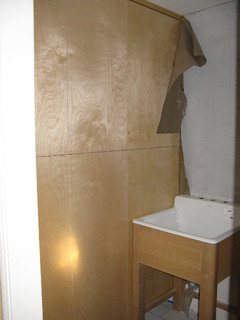
eastbaymom
13 years agolast modified: 9 years agoI did a search for you on "veneer" and found a particularly useful thread about particle board vs. plywood construction (see link below).
We used solid wood for our "reverse raised panel" door fronts, knowing that it might warp. I've had bad experience with cheap veneer cabinets in prior homes. However, there are also some really beautiful high end veneer slabs available now -- someone on here recently posted the most stunning sapele wood kitchen -- so I think you really have to find a way to assess quality.
carol08
Original Author13 years agolast modified: 9 years agoEveryone--
Please accept my apologies for not having searched thoroughly enough before posting. I did try some searching (and found, for example, a thread from a few months back on slab vs. shaker doors) but didn't find a whole lot. I suspect that the search function wasn't working quite right at the time (e.g., I tried to find a thread I had actually responded to recently, and it didn't come up)--but I should have thought to google gardenweb.Having said that, thanks so much for all of your help!
Sochi, I love your cabinets--your whole kitchen, in fact. Your cabinets certainly don't look cheap (and I'm sure they weren't inexpensive). It's interesting to know that they are veneer, and that you've had veneer before and haven't had any problems. I actually have custom built veneered cabinets in two bathrooms (mahogany, I think) which are more than 40 years old, and they still look great. But I worry more about kitchens, I guess.
kaismom: it was very helpful to hear about how the veneers are laid out (e.g., the sewing analogy was very informative), and I can see why it takes a lot of skill and why quality veneers would be pricey. I've looked at sochi's and cats_mom's kitchen pictures more than once (I love both of those kitchens), but I'll go back and look more carefully at the veneers with your comments in mind--and I'll definitely check out the companies you've mentioned. Thanks!
plllog: Your maple cabinets are lovely; I was stunned to read that they are in your laundry room! (I'm one of those people who still has the laundry in the ugly, unfinished part of the basement.) I wonder if the cabinet maker I've been considering (who is being pushed by a GC) has a special machine to apply edge banding. In fact, I wonder how much experience he has with veneer...GC says that if we want veneer from this cabinet maker we must go with MDF because the cabinetmaker says every other type of veneered door will warp...BTW, I'm impressed that you're going for (or already have?) bamboo in the kitchen. I've seen a lot of bamboo displays and I like the eco-friendliness of bamboo, but I don't yet know anyone with bamboo cabinets. I was looking into lyptus for a while, but the only person I could find who carried lyptus cabinets said I'd have to stain them very dark (which I didn't want to do), despite the fact that I'd seen pics of lyptus kitchens stained more the color of teak. I suspect he just didn't want to mess with lyptus.
eastbaymom: Thanks so much for the threat on particle board vs. plywood cabinet boxes. I'm sure it will be a great help. Sounds like you had the same worries that we've had and some bad experiences to boot. I actually haven't had trouble with veneers, but many people I've talked to have--and have tried to talk me out of slab. But those stunning GW kitchens (like the gorgeous sapele one) keep calling to me, so you folks are right: I need to find a way to assess quality --and then figure out whether I can afford it :-)
Thanks again, everyone!
plllog
13 years agolast modified: 9 years agoCarol,
Don't worry! It's much easier to search for something if you remember the thread than if you're trying to find it with basic search terms. When people suggest things to search for, and link old threads, they're trying to help.
The thing about MDF is that it is VERY flat and straight. It takes veneer beautifully and is very stable. Most craftsmen prefer it for hand applied veneer for that reason. As has been mentioned, it's the standard way to get exotic woods. Veneer can be done over plywood, but then the plywood has to be top quality to be as good as the MDF, at which point you might as well buy the plywood factory made with the veneer you want. It can also be done on boards, but same thing: might as well just start with great wood for all of the time and care that goes into preparing it. Worth it for fine furniture, but a needless expense for kitchen cabinets which could easily go stratospheric.
My laundry room is actually a laundry walk-in closet which is sectioned off of my kitchen. It was ripped out and rebuilt with new cabinetry as part of the kitchen remodel. The cabinet doors were going to be painted, and there was going to be a laminate veneer on the plywood inside the cabinets, but the no VOC plywood sample came in so beautiful that I told the cabinetmaker that it was too beautiful to paint. Say that to a wood guy and he's charmed enough to go the extra step. He did a lot of research and found the place that could do the low VOC hard varnish on it. I'm allergic to VOCs--shipping the plywood around isn't necessarily a green choice.
It's really hard to take pictures of the bamboo. The foreground part of the door, far right, looks the most like it does in person. It's blond, and quite yellow. This is a plywood made of inch wide strips of bamboo top and bottom, over a fill of narrow strips of bamboo stacked perpendicularly. It's also low to no VOC, and is supposed to be sustainable, but it is from China. I convinced the cabinetmaker that it did not require edgebanding, that the appearance of the bamboo was pretty. You can see the stacked bamboo in the edge of the center of picture part of the door. Top and bottom are the edges of the front and back strips, with the strand of bamboo in between.
You can see the same plywood as the laundry room doors inside the cabinet, with the edge banding on the shelves. I actually don't mind the look of sanded and polished plywood edges, but leaving that would have offended the cabinetmaker's sensibilities so I let him put edging. :) The skeptical look, I think, got me the tour of the edging machine. I can sense densities and papery thin veneers bother me. The band is a furniture grade veneer. I think that's the difference that the others were talking about in quality of veneers. Some are papery thin. Others are a sixteenth of an inch thick. And there are big differences in the adhesives too.
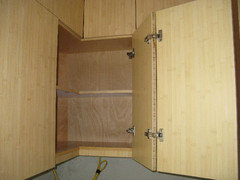
lisadlu
13 years agolast modified: 9 years agoCarol08 - We had the same dilemma. I wanted the modern look of all slab doors but liked the look of all wood (the veneers I found were not well done and some even looked "plastic"). I finally decided to go contemporary and did plain shaker doors on the uppers and all slab drawers on the bottom. I am using all horizontal bar pulls (even on the upper doors). We also went with walnut wood with walnut stain, the darker color won't hi-lite the shaker door as much. Good luck! Finally deciding on my door style was the decision that took me the longest.
carol08
Original Author13 years agolast modified: 9 years agoplllog: thanks for the very kind note. I guess I've always associated MDF with cheap cabinets, but I do understand that (as you pointed out), it provides a very flat, straight, and stable surface for applying veneer. Factory-made plywood also sounds appealing. But it's clear to me that the thing I really need to do is a lot more investigating into veener quality (thickness, mode of application, etc.). It sounds like there might be more ways to mess up when choosing veneer cabintes than when choosing solid wood in non-slab styles--but maybe it just seems that way because I haven't done much looking into the other types of doors.
Your cabinets (laundry room and kitchen) look great, plllog. Sounds like you have a great cabinetmaker who really takes pride in his work. And your bamboo looks different from some of the samples I've seen in showrooms around here (e.g., the grain runs vertically rather than horizontally, and the graining looks more subtle). Very pretty. It's also impressive that you've been adopting such a green approach. I just read about one cabinet company that will use low-VOC (or no-VOC) plywood (as an upgrade) but I hadn't thought about low VOC finishes. One more thing to consider. The more I investigate, the more it seems that there is to learn. Thank goodness for GW!
lisadlu: Thanks for the encouragement. It's reassuring to know that we're not the only ones having such a difficult time choosing door styles. We keep waffling back and forth and back and forth--and the shaker doors with slab drawers have been one of the options in the mix. I hadn't thought about how one might enhance the contemporary feel through stain and bar pulls though. Great ideas!
cienza
13 years agolast modified: 9 years agoI love the modern, sleek appearance of the slab door style. For our kitchen, we chose to get a solid slab style instead of a veneer slab style. If our daughters want to refinish the doors after my husband and I are long gone, they'll be able to do so. A veneer slab would not give future generations or future owners the option of refinishing. Also, my husband really likes the 'wood grain' and it was more natural on the solid door. It was a bit of a concession for me, but we couldn't afford the Pedrini I wanted anyway! As much as I love the high gloss lacquer, the european styling and super-modern look, it's just not practical for the money.
carol08
Original Author13 years agolast modified: 9 years agoHi cienza--I, too, like the idea of having the option to refinish solid wood doors, even if that wouldn't happen for many, many years--but DH hates the idea of battens. Do your doors have battens? If so, do they seem to encroach upon the space inside the cabints?
plllog
13 years agolast modified: 9 years agoCarol, my old kitchen had 25 year old laminated oak slab doors (i.e., made of boards slotted and glued together). No battens. The individual boards were 4-5" wide. I don't know if they were tongue in groove or biscuit joined, because they never gave me a moment's trouble. They didn't warp, they didn't split or delaminate, they weren't banged up, and the varnish was just beginning to go gummy. Some of the cabinets had died, and the rest were all wrong, but the ones that were in good shape went to Habitat and they were very happy to have them.
I would guess that battens would be more necessary on a softer or greener wood, but I don't know why people say you have to have them for slab. Most raised panel doors are laminated nowadays too and don't have battens.
Also, actual boards are still available if you want solid wood single plank doors, no battens. The thing is that they need to be dried first, preferable for at least a year on site. They get any cupping and shrinking they're going to do over with, and then are planed flat.
Any wood, whether solid or plywood or whatever, will warp when it gets good and wet. Plumbing leaks are the enemy of board slab doors.
BTW, while some of my materials choices were meant to be environmentally friendly, I really don't consider my remodel to be "green". The concern about VOCs came from being extremely allergic. Saving some pennies (lots and lots of pennies) on the kitchen, but not being able to go in because it was outgassing for three years would have been pound foolish. So then the cabinet foreman and helpers were doing some finishing, and I started getting sick...then hysterical. Luckily my GC had just arrived so when I came barrelling around the corner like a bean sidhe he was right on them. They had opened some kind of solvent. They had totally forgotten that this was a no VOC zone (and probably didn't think that this thinner or whatever it was had anything to do with my very expensive zero VOC materials) and couldn't believe that with all the draping and no HVAC that I got so sick so fast in a totally different portion of the house. Couldn't go back in for hours.
cienza
13 years agolast modified: 9 years agoCarol08, I'm not sure what a 'batten' is. I can tell you the cabinetry we have is called 'framed'. Frameless cabinetry has no face frame to which the doors are attached. Our doors close onto to a piece of wood on the front side of the box that sort of encroaches into the area you put stuff into, not the side of the cabinet box. That piece doesn't really get in the way of getting any item into the cabinet, rather, it clearly defines where the end of the stuffing area is so I don't overstuff the insides. Some framed cabinet boxes have a stile between double door openings. Ours do not because I chose boxes narrow enough that it would not be structually necessary. All my boxes have double door openings with no obstruction between each door. That was important to me for wide items like pots & pans, small appliances etc. Also, my husband has installed framed cabinets before, but not frameless. He was more comfortable with framed and liked the structrual integrity of those boxes alot more. He did not like any of the frameless boxes I showed him that I liked. He thought they were cheaply made, poorly constructed and exhibited tell-tale signs of bad craftsmanship. Apparently, I have cheap taste. I am very happy with his choice of cabinetry since it met his and my criteria. His was construction, durability and workmanship, mine was modern style.
carol08
Original Author13 years agolast modified: 9 years agoHi cienza,
Thanks for the reply. It sounds like you don't have battens, because you definitely would have noticed them, even if you hadn't known what they were called. As I understand it, a solid slab door usually isn't constructed out of one solid piece of wood. Instead, some wide strips of solid wood are glued (or otherwise fastened together). Then, to keep the doors from warping if those pieces of wood expand and contract unevenly, manufacturers put some narrow pieces of wood on the back side of the doors, running horizontally, called battens. One can't see the battens if the doors are closed, but when one opens the doors, they are very visible and my DH hates them. I also wonder if they interfere a lot with things inside the cabinet since they intrude a little bit into the inside of the cabinet box.BTW, your description of your framed cabinets was helpful. We've been mostly looking at frameless (because, like you, we like the more modern style) but have found that some companies deal only in framed models so we've wondered if we could live with those. Your framed cabinets without center stiles between door openings sound like a nice compromise.
andersons21
13 years agolast modified: 9 years agoNarrow boards glued together into a wider board are not "laminated." In wood, lamination refers to layers glued together in thickness, as in plywood.
The frame helps prevent the panel from warping because the rails apply a cross force to the glued-up boards in the panel. This is the major reason for the traditional design, not just to arbitrarily make more work for the cabinet maker. Battens on the back of a slab door provide a similar cross force. Aprons on a table, likewise. In virtually any traditional design with wood, that cross force is applied in some way.
Honestly, I think it's a bit silly to "hate" the battens on the inside of a door that prevent it from warping.
But if there is no batten, I would choose veneer over plywood for the slab, making sure the same species and thickness of plies on both front and back to minimize warping. MDF is very heavy and often has hinge failures. And be much more careful than normal to make sure the doors remain dry and the finish intact.
The idea that you can find cabinet makers who don't use traditional design, or provide warranties, is no assurance the new design will hold up. In the old days, longevity was more valued and expected. (Some) cabinet makers today know that the average kitchen is replaced in X number of years because people move or want a new look. I find that in home construction in my area, it's possible (easy even) to find workers in every trade who will do work in a way that is highly likely to fail prematurely.
carol08
Original Author13 years agolast modified: 9 years agoHi andersons,
Sorry for the slow reply. I was called out of town unexpectedly and wasn't able to check GW.Your comments about cabinet construction are very informative--especially your explanation of the principle of cross force. It's also helpful to know that the weight of MDF doors can lead to hinge failures. I'd imagine that would be especially problematic for very large doors. And I hadn't realized that the thickness and species of wood veneer on the two sides of a door could influence warping tendencies. Makes perfect sense, but it hadn't occurred to me.
As for local cabinet makers, I love the idea of supporting individual craftsmen and the potential for complete customization. But I'm not planning to remodel again or move in a few years, and I worry that I don't know enough about the craft to detect the sorts of defects that will cause premature failure.
And, yes, I suppose it is a bit silly to hate battens, but DH feels that they detract from the clean look of the cabinets (albeit only when the doors are open) and worries that their intrusion into the cabinet box could interfere with optimal shelf placement and/or storage of large items like dinner plates. If forced to choose, however, we both value function over form so we may end up with battens--or with a more traditional door style.
Thanks again for your help.
clg7067
13 years agolast modified: 9 years ago"Narrow boards glued together into a wider board are not "laminated." In wood, lamination refers to layers glued together in thickness, as in plywood."
Thats odd, the lumber yard that made my solid cherry table top called the process "laminating". They used four 4/4 solid cherry boards to make my 30 x 50 table top.
You'd think a lumber yard would use the correct terminology.
wolfgang80
13 years agolast modified: 9 years agoDo any of the warping concerns of slab doors apply to slab front drawers in base cabinets? If yes, at what size does this start becoming a concern?
plllog
13 years agolast modified: 9 years agoI'm wondering if the whole warping concern is influenced a lot by climate. The only doors with battens I've seen here were pine and/or made to look rustic, but the climate is very mild. In a place where it's hot and dry in the kitchen from the heating in the Winter, and heavily humid in the Summer, the wood might go through phases of absorbing moisture and drying out.
plllog
13 years agolast modified: 9 years agoBTW, you shouldn't have any trouble with MDF and good quality hinges, especially Euro style ones. Standard Euro style slab doors are made out of MDF and the hinges are made to hold it. Thirty year old kitchens in the style still function fine.
carol08
Original Author13 years agolast modified: 9 years agoI suspect that plllog is right, that cabinet warping is a bigger issue when winters are very cold and summers are hot and humid. Indeed, one cabinet installer told me that to prevent warping one had to try to keep humidity levels consistent by always running the humidifier in the winter and always using the AC (which dehumidifies) in the summer. I prefer to use AC as little as possible (in order to save energy and enjoy fresh air), so I wasn't thrilled to hear that.
Good to know that MDF shouldn't be a problem if one is using good quality Euro-style hinges.
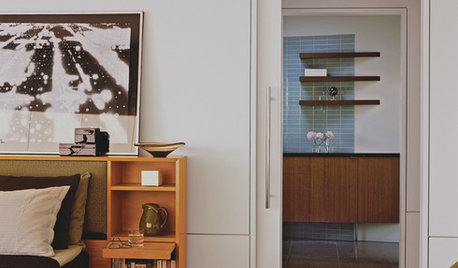





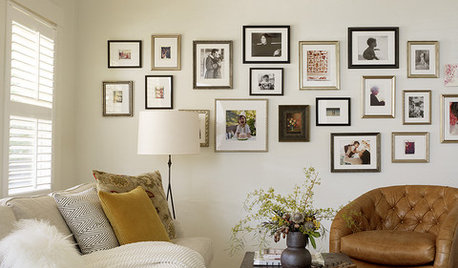
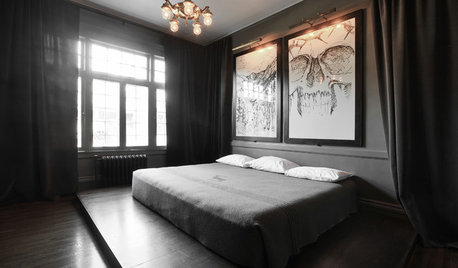

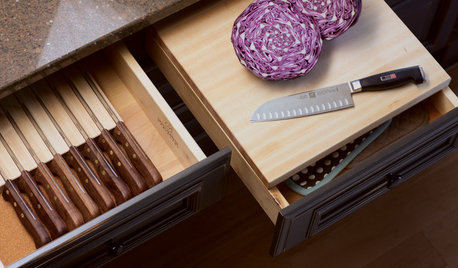



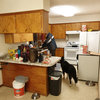
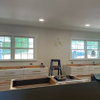
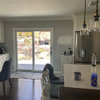
carol08Original Author